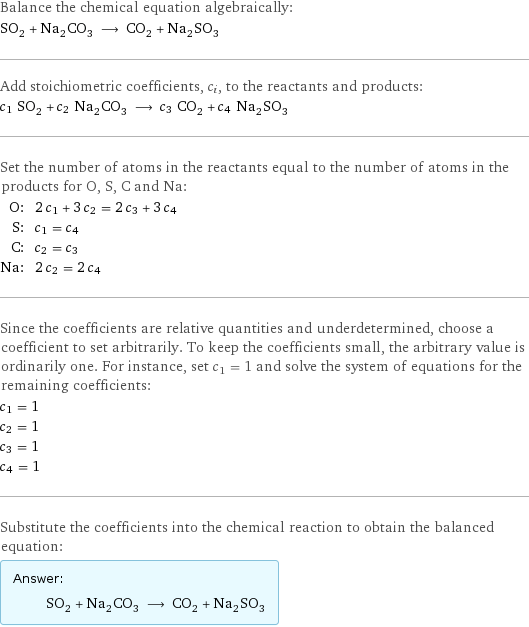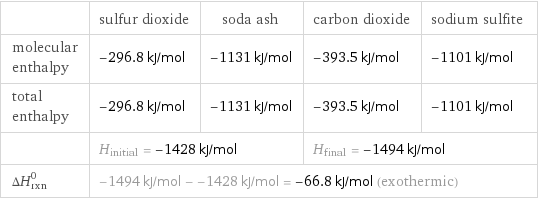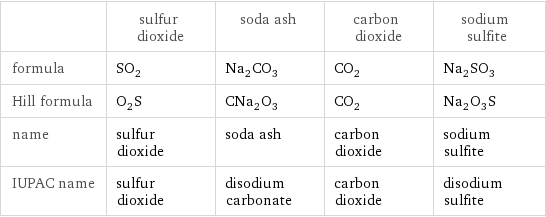Input interpretation

SO_2 sulfur dioxide + Na_2CO_3 soda ash ⟶ CO_2 carbon dioxide + Na_2SO_3 sodium sulfite
Balanced equation

Balance the chemical equation algebraically: SO_2 + Na_2CO_3 ⟶ CO_2 + Na_2SO_3 Add stoichiometric coefficients, c_i, to the reactants and products: c_1 SO_2 + c_2 Na_2CO_3 ⟶ c_3 CO_2 + c_4 Na_2SO_3 Set the number of atoms in the reactants equal to the number of atoms in the products for O, S, C and Na: O: | 2 c_1 + 3 c_2 = 2 c_3 + 3 c_4 S: | c_1 = c_4 C: | c_2 = c_3 Na: | 2 c_2 = 2 c_4 Since the coefficients are relative quantities and underdetermined, choose a coefficient to set arbitrarily. To keep the coefficients small, the arbitrary value is ordinarily one. For instance, set c_1 = 1 and solve the system of equations for the remaining coefficients: c_1 = 1 c_2 = 1 c_3 = 1 c_4 = 1 Substitute the coefficients into the chemical reaction to obtain the balanced equation: Answer: | | SO_2 + Na_2CO_3 ⟶ CO_2 + Na_2SO_3
Structures

+ ⟶ +
Names

sulfur dioxide + soda ash ⟶ carbon dioxide + sodium sulfite
Reaction thermodynamics
Enthalpy

| sulfur dioxide | soda ash | carbon dioxide | sodium sulfite molecular enthalpy | -296.8 kJ/mol | -1131 kJ/mol | -393.5 kJ/mol | -1101 kJ/mol total enthalpy | -296.8 kJ/mol | -1131 kJ/mol | -393.5 kJ/mol | -1101 kJ/mol | H_initial = -1428 kJ/mol | | H_final = -1494 kJ/mol | ΔH_rxn^0 | -1494 kJ/mol - -1428 kJ/mol = -66.8 kJ/mol (exothermic) | | |
Gibbs free energy

| sulfur dioxide | soda ash | carbon dioxide | sodium sulfite molecular free energy | -300.1 kJ/mol | -1044 kJ/mol | -394.4 kJ/mol | -10125 kJ/mol total free energy | -300.1 kJ/mol | -1044 kJ/mol | -394.4 kJ/mol | -10125 kJ/mol | G_initial = -1345 kJ/mol | | G_final = -10519 kJ/mol | ΔG_rxn^0 | -10519 kJ/mol - -1345 kJ/mol = -9175 kJ/mol (exergonic) | | |
Equilibrium constant
![Construct the equilibrium constant, K, expression for: SO_2 + Na_2CO_3 ⟶ CO_2 + Na_2SO_3 Plan: • Balance the chemical equation. • Determine the stoichiometric numbers. • Assemble the activity expression for each chemical species. • Use the activity expressions to build the equilibrium constant expression. Write the balanced chemical equation: SO_2 + Na_2CO_3 ⟶ CO_2 + Na_2SO_3 Assign stoichiometric numbers, ν_i, using the stoichiometric coefficients, c_i, from the balanced chemical equation in the following manner: ν_i = -c_i for reactants and ν_i = c_i for products: chemical species | c_i | ν_i SO_2 | 1 | -1 Na_2CO_3 | 1 | -1 CO_2 | 1 | 1 Na_2SO_3 | 1 | 1 Assemble the activity expressions accounting for the state of matter and ν_i: chemical species | c_i | ν_i | activity expression SO_2 | 1 | -1 | ([SO2])^(-1) Na_2CO_3 | 1 | -1 | ([Na2CO3])^(-1) CO_2 | 1 | 1 | [CO2] Na_2SO_3 | 1 | 1 | [Na2SO3] The equilibrium constant symbol in the concentration basis is: K_c Mulitply the activity expressions to arrive at the K_c expression: Answer: | | K_c = ([SO2])^(-1) ([Na2CO3])^(-1) [CO2] [Na2SO3] = ([CO2] [Na2SO3])/([SO2] [Na2CO3])](../image_source/a4ead22c89419955ee3210455336ae25.png)
Construct the equilibrium constant, K, expression for: SO_2 + Na_2CO_3 ⟶ CO_2 + Na_2SO_3 Plan: • Balance the chemical equation. • Determine the stoichiometric numbers. • Assemble the activity expression for each chemical species. • Use the activity expressions to build the equilibrium constant expression. Write the balanced chemical equation: SO_2 + Na_2CO_3 ⟶ CO_2 + Na_2SO_3 Assign stoichiometric numbers, ν_i, using the stoichiometric coefficients, c_i, from the balanced chemical equation in the following manner: ν_i = -c_i for reactants and ν_i = c_i for products: chemical species | c_i | ν_i SO_2 | 1 | -1 Na_2CO_3 | 1 | -1 CO_2 | 1 | 1 Na_2SO_3 | 1 | 1 Assemble the activity expressions accounting for the state of matter and ν_i: chemical species | c_i | ν_i | activity expression SO_2 | 1 | -1 | ([SO2])^(-1) Na_2CO_3 | 1 | -1 | ([Na2CO3])^(-1) CO_2 | 1 | 1 | [CO2] Na_2SO_3 | 1 | 1 | [Na2SO3] The equilibrium constant symbol in the concentration basis is: K_c Mulitply the activity expressions to arrive at the K_c expression: Answer: | | K_c = ([SO2])^(-1) ([Na2CO3])^(-1) [CO2] [Na2SO3] = ([CO2] [Na2SO3])/([SO2] [Na2CO3])
Rate of reaction
![Construct the rate of reaction expression for: SO_2 + Na_2CO_3 ⟶ CO_2 + Na_2SO_3 Plan: • Balance the chemical equation. • Determine the stoichiometric numbers. • Assemble the rate term for each chemical species. • Write the rate of reaction expression. Write the balanced chemical equation: SO_2 + Na_2CO_3 ⟶ CO_2 + Na_2SO_3 Assign stoichiometric numbers, ν_i, using the stoichiometric coefficients, c_i, from the balanced chemical equation in the following manner: ν_i = -c_i for reactants and ν_i = c_i for products: chemical species | c_i | ν_i SO_2 | 1 | -1 Na_2CO_3 | 1 | -1 CO_2 | 1 | 1 Na_2SO_3 | 1 | 1 The rate term for each chemical species, B_i, is 1/ν_i(Δ[B_i])/(Δt) where [B_i] is the amount concentration and t is time: chemical species | c_i | ν_i | rate term SO_2 | 1 | -1 | -(Δ[SO2])/(Δt) Na_2CO_3 | 1 | -1 | -(Δ[Na2CO3])/(Δt) CO_2 | 1 | 1 | (Δ[CO2])/(Δt) Na_2SO_3 | 1 | 1 | (Δ[Na2SO3])/(Δt) (for infinitesimal rate of change, replace Δ with d) Set the rate terms equal to each other to arrive at the rate expression: Answer: | | rate = -(Δ[SO2])/(Δt) = -(Δ[Na2CO3])/(Δt) = (Δ[CO2])/(Δt) = (Δ[Na2SO3])/(Δt) (assuming constant volume and no accumulation of intermediates or side products)](../image_source/4db41ff41ae27e012f12fee514090d4d.png)
Construct the rate of reaction expression for: SO_2 + Na_2CO_3 ⟶ CO_2 + Na_2SO_3 Plan: • Balance the chemical equation. • Determine the stoichiometric numbers. • Assemble the rate term for each chemical species. • Write the rate of reaction expression. Write the balanced chemical equation: SO_2 + Na_2CO_3 ⟶ CO_2 + Na_2SO_3 Assign stoichiometric numbers, ν_i, using the stoichiometric coefficients, c_i, from the balanced chemical equation in the following manner: ν_i = -c_i for reactants and ν_i = c_i for products: chemical species | c_i | ν_i SO_2 | 1 | -1 Na_2CO_3 | 1 | -1 CO_2 | 1 | 1 Na_2SO_3 | 1 | 1 The rate term for each chemical species, B_i, is 1/ν_i(Δ[B_i])/(Δt) where [B_i] is the amount concentration and t is time: chemical species | c_i | ν_i | rate term SO_2 | 1 | -1 | -(Δ[SO2])/(Δt) Na_2CO_3 | 1 | -1 | -(Δ[Na2CO3])/(Δt) CO_2 | 1 | 1 | (Δ[CO2])/(Δt) Na_2SO_3 | 1 | 1 | (Δ[Na2SO3])/(Δt) (for infinitesimal rate of change, replace Δ with d) Set the rate terms equal to each other to arrive at the rate expression: Answer: | | rate = -(Δ[SO2])/(Δt) = -(Δ[Na2CO3])/(Δt) = (Δ[CO2])/(Δt) = (Δ[Na2SO3])/(Δt) (assuming constant volume and no accumulation of intermediates or side products)
Chemical names and formulas

| sulfur dioxide | soda ash | carbon dioxide | sodium sulfite formula | SO_2 | Na_2CO_3 | CO_2 | Na_2SO_3 Hill formula | O_2S | CNa_2O_3 | CO_2 | Na_2O_3S name | sulfur dioxide | soda ash | carbon dioxide | sodium sulfite IUPAC name | sulfur dioxide | disodium carbonate | carbon dioxide | disodium sulfite